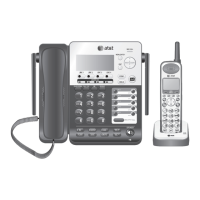hears “No one is available to answer the call. To leave a message press
1, to call another extension press 2, to call the operator press star.” and
waits five seconds for another entry from the caller. If the caller still hasn’t
entered an extension number after hearing this message three times, the
auto attendant forwards the call to the general mailbox to leave a message.
If the caller enters an invalid extension number, the auto attendant
announces, “Please wait, this number is not assigned. To leave a message,
press 1, to call another extension, press 2, to call the operator, press star.”
If the caller enters the star key (*) plus the pound key (#), the auto
attendant announces ”Calling the operator,” and then transfers the call to
the telephone base.
If the caller enters the remote access code while hearing the
announcement, the auto attendant stops playing the announcement and the
caller can remotely access the general mailbox (See Remote access on
page 77 for information).
If the caller does not enter any number after hearing the announcement,
the auto attendant announces three times “Please enter your party’s
extension, followed by the pound key. If you are using a rotary telephone,
please stay on the line. For a company directory, dial star twice.” Then the
auto attendant transfers the call to the general mailbox for the caller to
leave a message.
Using multiple auto attendants
Use this feature to set one or more telephone lines to act
as auto attendants when the primary auto attendant is
turned off or busy.
An auto attendant is busy when someone at that extension is doing any of
the following:
dialing from the directory or call history
using any of the lines to make or answer a call
when the answering system is recording a message at that extension
•
•
•
Answering system
Auto attendant operation
*:Base
0 Missed call
08:00AM 12/30
AuAt AuAt
You can choose a particular telephone line to always be the primary
auto attendant by setting that line to have the shortest auto attendant
pickup delay (number of rings) and setting the pickup delays of other auto
attendants with a longer pickup delay (more rings). If the auto attendant
pickup delays are the same, incoming calls are distributed randomly to the
auto attendants.
70

